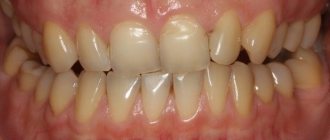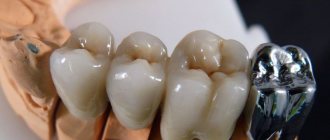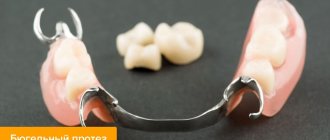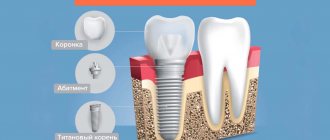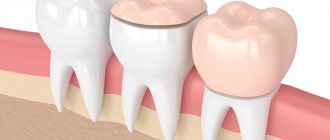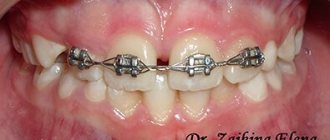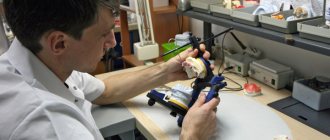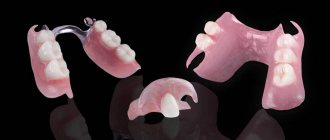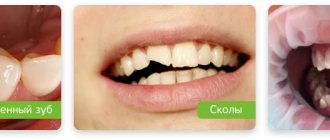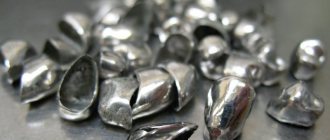Through prosthetics, it is possible to restore the integrity of the dentition, as well as the appearance and shape of damaged teeth. The choice of the type of false teeth depends on the condition of the oral cavity, the health of the patient and the financial aspect. The main task of the orthopedist is to restore the chewing function of the dentofacial apparatus. For the patient, the aesthetics and comfort of wearing the prosthesis are no less important.
Main types of dentures
This is the name given to custom-made orthopedic structures that replace lost teeth. They are installed with the aim of restoring the aesthetic appearance and chewing function, as well as eliminating diction disorders.
Based on the type of fixation in the oral cavity, there are three main types of prostheses:
- non-removable – designed to replace several missing dental units (bridges) or restore a damaged tooth (crowns, inlays, veneers);
- conditionally removable - can only be removed by a specialist for maintenance or repair, attached to pins implanted in the jaw;
- removable - products made of metal, plastic, which are fixed with different types of fastenings to healthy teeth or with the help of special glue in case of complete edentia. Constructions of this type are divided into complete and incomplete in terms of volume of replacement of dental units.
Complete dentures
Designed to restore teeth when they are completely missing, they are made of hypoallergenic acrylic plastics. They consist of a base adjacent to the gum and crowns attached to it. A well-made artificial upper jaw is held in place well by negative pressure between the gum and the denture bed. The lower denture, as a rule, is less well fixed, so dentists recommend additionally using special adhesives.
Complete denture
Partial
They are installed in the presence of supporting dental units, correcting included or end defects. Metal, plastic, acrylic in various combinations are used in production. Modern orthopedic dentistry offers several options for partial structures that are fixed with locks, clasps, and other types of fasteners. The chewing load is evenly distributed both on the jaw tissue and on the prosthesis.
Implantation
The procedure of implanting a metal root to replace the lost one and then attaching a crown to it is called implantation. The peculiarities of this procedure lie in its step-by-step implementation.
First, a metal rod is installed, wait for it to heal, and then a crown is attached on top.
The dentist recommends that the patient choose one or another crown material and the type of metal pin that is optimal in shape and type of thread.
Pros of implantation:
- quality result;
- high aesthetics;
- durability.
The obvious disadvantages of implantation include:
- duration of the procedure (from several months to a year);
- high cost of one implant;
- presence of contraindications;
- the possibility of complications, rejection and the occurrence of inflammatory processes around the implant.
The cost of implants depends on the manufacturer, materials used and design features.
Domestic, Korean and Israeli budget options cost from 20,000 rubles, while imported premium elements can cost from 40,000 - 50,000 rubles.
Types of removable dentures
This category includes designs that can be removed, cleaned, and put on independently, without the help of a specialist. They are indicated for complete or partial absence of teeth; they can be permanent or temporary. The following types of removable dentures are distinguished:
- lamellar;
- clasp;
- immediate dentures;
- quadrotti;
- sandwich dentures.
Removable prosthetic structures perform an aesthetic function and promote better chewing of food. The advantages of this method of prosthetics include speed of installation and relatively low cost. Permanent structures have significantly more disadvantages.
First, the gum tissue atrophies, making it necessary to replace the artificial jaw every 2 or 3 years. Secondly, plate dentures are not securely fixed in the oral cavity and can distort diction. Thirdly, the materials used wear out quickly and are not very durable. Below are detailed characteristics of each type of removable dentures.
Suction cup or plate prosthesis
An inexpensive and simplest method of prosthetics for complete or significant absence of teeth. The prosthesis consists of a base made from an individual impression and crowns. To make the base, hard hypoallergenic materials (acrylic, plastic) or soft nylon are used.
If several dental units have been preserved, the artificial jaw is attached to them using clasp hooks. In the case of complete edentia, fixation is carried out by suction of the base bed to the gum tissue. For more reliable fastening, dentists recommend using special adhesive compounds (creams, glues).
Complete removable dentures for the upper jaw have a design feature. They completely cover the palate, which increases their surface area and, accordingly, the reliability of fixation in the oral cavity. Prosthetics of the lower jaw in a similar way is undesirable, because the product, without a palatal part, is less well retained in the mouth.
Dentists do not recommend this type of prosthetics for several reasons:
- due to the high load on the gums, hard and soft tissues quickly atrophy, which leads to the need for frequent replacement of dentures;
- design features often contribute to impaired diction and can provoke an inflammatory process;
- patients complain of a long process of getting used to it, discomfort while wearing it, and gagging;
- the prosthesis is not sufficiently securely fixed in the oral cavity, restoring chewing function by no more than 65%;
- the materials used in manufacturing are not very durable; plastic can cause an allergic reaction.
Removable prosthetic structures are still in high demand because they are inexpensive, quickly manufactured, and easy to maintain.
Immediate prosthesis
Also known as a “butterfly” or “bug”, it is a temporary type of prosthetics for 1-3 dental units. It is usually installed before implantation for the period necessary for the engraftment of titanium pins. At this time, a removable denture is necessary to maintain chewing function, maintain aesthetics, and also to prevent tooth discrepancy.
The design received its name due to the similarity of its supporting part to the open wings of an insect. The base is usually made of soft materials, colored to match the gum, and the crowns are made of white acrylic plastic. The denture is attached to healthy teeth using clasps, which are almost invisible when smiling or talking. Immediate dentures are inexpensive, are manufactured in 2-3 days, and look aesthetically pleasing.
Immediate prosthesis
Clasp prosthesis
One of the highest quality modern types of prosthetics for partially edentulous patients. The design is comfortable to wear, aesthetically pleasing, and durable. In addition, the chewing load is evenly distributed between the supporting dental units, which significantly slows down bone tissue atrophy. To install this type of structure, you must have your own healthy teeth on both sides of the jaw.
The clasp prosthesis consists of three main parts:
- metal frame made of titanium, precious metals or cobalt-chromium alloy (CHC);
- a base made of nylon or acrylic, with plastic teeth;
- fixation systems (locks, clasps, telescopic crowns).
The basis of the metal frame is an arc, which serves as a load distribution and ensures the strength of the entire structure. On the upper jaw, it can be in three positions - in front, in the middle or behind - or have a closed ring-shaped shape. when replacing the lower jaw, this element has an exclusively anterior position.
The arc does not come into contact with the mucous membrane and has a small thickness. A nylon or acrylic base with crowns is welded onto it. The thickness and volume of the base are reduced due to the presence of a durable metal frame. This increases the comfort of wearing clasp structures and makes them one of the best dentures for teeth. The reliability of fixation in the oral cavity depends on the type of attachment to the supporting dental units.
On clasps
This is the name for hooks that are placed on healthy crowns, transferring pressure to them and keeping the prosthesis from moving. They are usually made of metal, but if they fall into the smile zone, they can be made of nylon (it is almost invisible). Clamp fastening has the following advantages:
- reliable fixation;
- comfort, quick adaptation;
- no need to grind your own crowns;
- affordable price (compared to other options).
The disadvantages include low aesthetic characteristics, but this only applies to metal clasps. In addition, such fastenings negatively affect the condition of supporting teeth, accelerating their destruction. The reason is the slight elasticity of the hook required to remove or put it on. As a result, it becomes mobile, gradually wearing away the enamel. But this problem can be solved by installing metal-ceramic crowns.
On locks
Fixation of the prosthesis is ensured by metal micro-locks or attachments consisting of two parts. One of them is located on the prosthesis itself, and the second is on the metal-ceramic crown of the abutment tooth. The design of this fastening is reliable and also redistributes about half of the chewing load onto healthy teeth.
The advantages of clasp dentures with attachments include:
- high aesthetics - the locks are located on the inner surface of the teeth, therefore they are completely invisible;
- reliable fixation;
- long service life - about 7 years;
- high rates of restoration of chewing function;
- no pain, discomfort, quick adaptation.
Among the disadvantages, one can highlight the rather high cost of production, which is due to its complexity. In addition, for prosthetics, it is necessary to grind down your own teeth in order to install metal-ceramics.
On telescopic crowns
The most technically complex, but the most effective way to fix the prosthesis in the mouth. The fastening element consists of two parts - a metal cap and a metal-ceramic crown. The first of them is placed on a ground healthy tooth, and the second is attached to the frame of the prosthesis. During installation, the crown is placed on the cap, ensuring the most reliable fixation. Therefore, to the question of which clasp dentures are the best, we can confidently answer that these are the ones.
The advantages of products with telescopic crowns include:
- reliability;
- durability;
- aesthetics.
The main disadvantage of this type of construction is its high cost, since it is necessary to install crowns on at least 4 abutment teeth.
Quadrotti
The name of the design comes from the Italian QuattroTi - the latest development by European scientists in the field of prosthetics. The principle of manufacturing and fixation of the prosthesis is similar to the clasp one, but differs in the material of manufacture. Instead of metal, it uses acetal - a monomer-free plastic, which is characterized by increased strength, 100% hypoallergenicity, and lightness.
Quadrotti prosthesis
This material made it possible to improve the performance qualities of the artificial jaw without compromising other significant properties. The weight of the structure has decreased, the strength is not inferior to its metal counterpart, and there is no risk of allergic reactions. In addition, Quadrotti clasps, made of acetal, are completely invisible on the teeth.
QuattroTi clasp dentures are superior to their clasp-based counterparts in the following indicators:
- aesthetics – the material for making fasteners is available in ten shades of white;
- comfort – the design is light and non-bulky, so adaptation occurs quickly and diction is not impaired;
- long service life - at least 7 years;
- hypoallergenic - unlike metal, acrylic or plastic, it is not able to provoke an allergic reaction.
Quadrotti prostheses are not inferior to their metal counterparts in strength, but have one significant drawback. Their clasps do not perform a supporting function, but only hold them, so there is no redistribution of the chewing load on the supporting teeth. All the pressure is placed on the gum tissue, which can cause pain when chewing. In addition, the price of QuattroTi is higher.
Sandwich
This is the name of a new generation of removable prosthetic structures for the upper jaw without a palate. It is a domestically developed product, made from acrylic plastics. It is recommended for patients who have retained at least two of their own teeth that will serve as supporting teeth. This type of dentures is also suitable if there are no teeth, but 2 implants are installed.
The base is fixed on the gum due to two fasteners that repeat the anatomical shape of the existing dental units. Due to the absence of the palatal part, the product is superior to the standard removable analogue in the following respects:
- does not cause a gag reflex;
- does not provoke inflammation;
- does not impede diction;
- no need to remove at night;
- no need to use adhesives;
- more durable and lighter.
The only disadvantages of the sandwich can be considered a higher cost or the need to install two implants if your own teeth are completely missing.
What are crowns needed for?
A crown is a denture and is an imitation of a real tooth. It can replace a lost tooth, and also fix a weakened or destroyed dental organ.
If only the root remains of the tooth, a pin or inlay is inserted into it, onto which the crown is then attached. If there is a crown part of the tooth, when it is in poor condition, the tooth is depulped, ground down and a crown is put on it. A crown makes sense when the tooth is more than half destroyed, as well as when there is excessive abrasion of the enamel and visual defects (cracks, stains, etc.).
In prosthetics, both single crowns and products welded together into a bridge can be used.
Types of fixed dentures
This type of prosthetics is indicated in the case of incomplete edentia - the absence of one to three teeth or their fragments. Its essence is to fix prosthetic structures on hard tissues using special cementing compounds. Fixed dentures can be temporary or permanent; they are made of zirconium dioxide, ceramics, composite materials, metal, and plastic.
Installation of this type of prosthesis allows you to solve a variety of problems. With the help of bridges, dental defects such as the absence of up to 3 adjacent teeth are eliminated. Cracks or chips of the enamel are masked with overlays - veneers or lumineers, which are firmly attached and prevent further destruction of hard tissues. In case of significant damage to the molars, inlays are installed instead of fillings. In case of partial or complete loss of the crown, an artificial analogue is placed.
Crowns
They are caps made of various materials that are hermetically placed on a specially prepared natural tooth. Preparation consists of preliminary treatment, depulpation (if necessary), and grinding. After preparation, an anatomically shaped prosthesis is made from the impression taken, and its temporary installation is performed. After a month, the dentist eliminates the identified deficiencies of the artificial crown and performs permanent fixation with medical cement.
Dental crowns
This type of prosthetics is performed using various materials:
- Metal – alloy of cobalt with chromium, precious metals. It is used in modern dentistry only for prosthetics of chewing teeth, since it looks unnatural. Metal crowns are the most durable and also the cheapest (if they are made by KHS).
- Metal-ceramics is a combination of a metal base with a ceramic coating. A more expensive and aesthetic option, not inferior in strength to the previous one.
- Ceramics is lithium disilicate, which is a durable material that fully matches natural tooth enamel in transparency and color.
- Zirconium dioxide - the best dentures that can be made are made from it - durable, aesthetic, but expensive.
- Plastic - used as a temporary overlay or for cladding a metal structure. It quickly darkens, deteriorates, and stains, but is very cheap.
Crowns are the optimal way to restore a tooth that is more than half destroyed. Installing a crown restores the ability to chew food properly and makes your smile aesthetically pleasing.
Bridges
Fixed orthopedic structures designed for prosthetics of 1-2 (less often three) dental units in a row. Longer products are impractical because they do not bear the chewing load and do not have increased strength. Bridges are a series of monolithic crowns that are attached to supporting teeth or implants. They are made from modern materials - metal ceramics, zirconium dioxide, and metal. Depending on the method of fastening, they are divided into several types.
Adhesive
Recommended for prosthetics if you need to preserve healthy abutment teeth. A design feature of this type of bridge is the fastening in the form of thin horizontal fiberglass plates, which are fixed on the inner surface of one’s own teeth. The design is quite durable, and also has a number of other advantages:
- aesthetics - the fastenings are invisible because they are located on the tongue side;
- safety – healthy teeth are not subjected to grinding:
- low price - formed by reducing material consumption.
The disadvantages of an abrasive prosthesis include its fragility (average service life is no more than 2 years), as well as the thickening of the supporting teeth. The last factor is a consequence of applying fastenings and takes some time to get used to.
Cantilevered
Suitable for eliminating a single defect, since only the teeth on one side are used as support. The supporting units (one or more) are ground, and a crown with a console made of zirconium or metal-ceramics is fixed on them. Since this type of fastening cannot be considered sufficiently reliable, cantilever bridges can only replace incisors with canines.
This design lasts about 5-7 years, but does not slow down bone tissue atrophy and is not highly durable. In addition, the supporting tooth gradually shifts, so consoles are placed only when it is impossible to use the teeth on both sides as support. For the same reason, this type of prosthetics does not correct end defects.
Composite
A bridge of this type is placed in cases where the axes of the supporting teeth are not parallel to each other. The structural elements are movably connected using hinges, clasps, and the “groove-ball” system. The main advantage of a composite bridge prosthesis is the possibility of prosthetics of inclined dental units. In addition, they are quite durable (last 12-15 years) because they are made of metal.
Combined
Solid metal dentures are characterized by increased strength and also do not require significant grinding of the teeth. However, due to their low aesthetic appeal, they are used for prosthetics exclusively for molars. If part of the prosthesis is visible, metal can be combined with metal ceramics. For example, the crowns on teeth 7 and 6 should be made cobalt-chrome, and those on teeth 5 and 4 – metal-ceramic. This reduces the cost of making a prosthesis without compromising your smile.
Microprostheses
Microprosthetics are used for partial destruction of the crown, chips and damage to tooth enamel. It is an intermediate link between filling and installation of a prosthesis. Microprostheses are made of composite materials, metal, ceramics, and are fixed using cement or special glue.
Veneers and Lumineers
They are thin ceramic plates designed to correct defects in the front teeth:
- cracks;
- chips;
- spots;
- darkening of the enamel;
- gaps, irregularities;
- thinning of enamel.
Veneers are coverings for teeth
Lumineers with a thickness of 0.2 mm are more expensive, but have a service life of 20 years, do not require significant grinding of teeth, and are fixed with glue. Veneers are cheaper, but you will have to prepare about 0.7 mm of hard tissue, attach the plates with cement, and the service life of the lining is no more than 15 years.
Tabs
This method of prosthetics is suitable for restoring the crowns of chewing teeth. The orthopedic dentist makes an impression, with the help of which a microprosthesis is made from metal or composite. It is attached with cement and is several times stronger than conventional fillings. If the crown is completely destroyed, a metal or metal-ceramic core inlay is placed.
Dentures on implants
The best dentures that can be installed as quickly, efficiently, and for a long time are designs on implants. They are classified as conditionally removable, since only a specialist can remove or install them. The prosthesis consists of an artificial jaw with teeth, titanium pins, and abutments. Compared to traditional implantation, this prosthetic method has several advantages:
- installation in 1 day;
- no bone tissue augmentation required;
- can be placed without age restrictions;
- the number or condition of the teeth does not matter.
All-on-4 technology is suitable for prosthetics of both jaws. The procedure is performed one day after preliminary sanitation of the oral cavity. Installs two pins in the patient’s jaw in the front, without tilting, and two more on the sides at an angle. Abutments are attached to the artificial roots, and an acrylic prosthesis is attached to them.
All-on-6 is a variation of the previous technique, but using 6 implants. Suitable for people with significant atrophy, reduced bone density, and those with periodontal disease. Implantation using this method provides more reliable fixation, requires more materials, and therefore costs more.
What to pay attention to before prosthetics
To choose the most suitable denture, you need to consider the following parameters:
- Condition of the mucous membrane of the gums. Periodontitis is a contraindication to almost all types of prosthetics.
- Crown placement: reversal and crowding.
- Condition of the crowns. If the crown is destroyed and cannot be restored with composite materials, then it is reconstructed using an anatomical inlay.
- Stability of the root system.
- The condition of the tissues in the cervical region and the root part of the tooth.
- Size of the defective area.
- Location of the dental unit being restored. This is the determining factor when choosing a material for making crowns.
When choosing a type of prosthetics, it is necessary to evaluate not only the design features of the products and the financial component, but also the state of health. Fixed dentures cannot be inserted into everyone; many diseases are a contraindication to their installation. It is important not to hide them from the dentist. It is he who must determine which false teeth are best to insert in a particular case.
Classification of prostheses by material
Several types of materials are used for prosthetics that meet the requirements and standards of modern orthopedic dentistry.
Acrylic
A universal type of plastic, characterized by plasticity, lightness, and an affordable price. It is used for the manufacture of all types of removable dentures, as well as bases for prosthetics on pins. Disadvantages include insufficient strength and fragility (they last about 5 years).
Acry-Free
Biocompatible monomer-free plastic of increased strength, completely hypoallergenic. Resistant to mechanical damage, elastic, used in the best removable dentures. The service life is at least 10 years.
Acry-Free prosthesis
Nylon
Modern elastic flexible material, characterized by low density and light weight, hypoallergenic. Suitable for the manufacture of elements of removable dentures - bases, fastenings. The disadvantages are insufficient strength and fragility - nylon products must be replaced every 5 years.
Silicone
Flexible prosthetic removable structures are called silicone, but this material itself is not used in orthopedic dentistry. Patients confuse it with nylon or monomer-free plastic AcriFree.
Plastic
Widely used in dental practice for the manufacture of artificial teeth, temporary crowns, and overlays for metal dentures. One of the advantages is its low cost, and the disadvantages are fragility and instability to coloring. Serves no more than 2 years.
Acetal
A type of monomer-free plastic characterized by high strength and resistance to adverse chemical and physical influences. Durable, completely biocompatible, does not cause allergies. Used in the production of clasp prostheses of the new generation Quadrotti.
Zirconium
The most durable of the materials used in prosthetics. It has high aesthetic properties and durability (lasts for decades). A conditional disadvantage can be considered the abrasion of the enamel of the teeth located on the opposite jaw. Used for the manufacture of fixed prostheses, including crowns for prosthetics on implants.
Ceramics
In its pure form, the ceramic base - porcelain - is rarely used in dentistry due to its increased fragility. However, its derivatives are widely used - different types of glass ceramics. The most expensive and aesthetically attractive fixed structures are made from them - crowns, veneers, lumineers. The service life is at least 20 years.
Metal ceramics
This is the name for the combination of a metal base with a ceramic coating. The advantages are strength, aesthetics, durability. With proper care, a metal-ceramic prosthesis will last more than ten years. Used in the manufacture of permanent structures.
Composite materials
Polymer multiphase compositions from inorganic filler, silicon hydride, organic matrix. Characterized by durability and long service life. Used as a filling material for microprosthetics.
Care
If you have dentures in your mouth, you should practice more careful oral hygiene. With a single crown, it will be enough to use a toothbrush, floss and toothpaste.
If you have bridges, hygiene can be significantly more complicated. Food often gets clogged under such a structure, which can sometimes be difficult to remove when using a brush or even thread.
But an irrigator can handle this well. A stream of water is supplied from it under pressure, which washes away food debris, soft plaque, and at the same time massages the gums.
Possible problems after installing crowns:
- The occurrence of caries under the crown. This occurs due to the formation of inflammation under the prosthesis due to poor cleaning of the dental canals or poor installation of the structure.
- Mobility of the prosthesis - can occur when poor cement is used to secure it or the shape is poorly calculated.
What dentures are the best and most comfortable?
Each prosthetic structure has specific characteristics that determine its scope of application.
For upper teeth
The incisors and canines experience less stress compared to the chewing teeth, and they are also within sight. For their prosthetics, the optimal types of fixed prostheses are crowns, adhesive bridges made of zirconium dioxide, glass-ceramics, and metal-ceramics. Molars and premolars are practically invisible, so it is advisable to install durable, inexpensive metal or combined dentures instead. For minor defects, veneers and lumineers are placed in front, and inlays are placed in the back.
Crowns on front teeth
For the bottom
The lower front teeth, like the upper ones, are also located in the smile zone, so fixed structures for them should be as aesthetic as possible. You can save a little on unobtrusive chewing dental units, so the recommendations are the same as in the previous paragraph.
With partial absence of teeth
In such cases, single defects are corrected with cantilever or adhesive bridges. You can also install immediate dentures during a two-stage implantation process. Severe edentia requires the installation of high-quality clasp dentures; you can also try a removable sandwich.
With complete edentia
Most often, inexpensive plate structures are used, but they deform the gums, do not hold well, and cause discomfort. The optimal solution in this case is complete dental implantation.
For temporary prosthetics
In such cases, immediate prostheses are usually used. Cantilever structures can also be used as non-permanent ones.
For children
Which dental prosthetics will be best for a child depends on the specific situation. Typically, children need butterfly dentures during the period of changing teeth to correct the dentition.
| Problem | Suitable prosthesis | Min. price, rub. |
| Upper and lower jaw: Minor, single defects of the anterior and posterior teeth | Ceramic veneers, lumineers | 8000-30000 |
| Zirconium crowns, 1 pc. | 30000 | |
| Metal-ceramic crowns, 1 pc. | 10000 | |
| Metal crowns, 1 pc. | 5000 | |
| Metal-ceramic bridge, 3 units. | 36000 | |
| Glass-ceramic bridge, 3 units. | 72000 | |
| Partial edentia | Adhesive bridge | 13000 |
| Cantilever bridge | 18000 | |
| Clasp prosthesis | 35000 | |
| Completely edentulous | All-on-4 | 400000 |
| All-on-6 | 500000 | |
| Temporary prosthesis | Metal-ceramic crown | 10000 |
| Changing teeth in children | Immediate prosthesis | 3000 |
The use of crowns to correct bites
Crowns are often placed on teeth to straighten them. However, this method is not always advisable to use. After all, before installing a crown, the dental organ must undergo quite extensive grinding. In addition, the nerve will be removed from it.
It is better to use ceramic veneers to correct crooked teeth. For them, the tooth does not need to be completely ground down. But it’s quite possible to correct minor bite defects with them.
However, most doctors recommend using braces to correct your bite.
